In this week’s top five, we take a break from June’s Bordeaux bias on the vinous calendar to look at the rising prices of Tuscany’s top wines.
However, there’s no escaping Bordeaux with Tuscany’s most expensive wine, since Masseto is distributed through the Place de Bordeaux. With tiny quantities available to purchase via the Place each year – average annual production is 32,000 bottles – Masseto’s price of £511 per bottle makes it well over a third more expensive than the rest of this weeks’ top five, and also the second-most expensive Italian wine on Wine Lister (beaten only by Giacomo Conterno’s Barolo Monfortino Riserva).
Masseto also achieves the group’s best Brand score (977), the result of featuring in the highest number of the world’s top restaurants (24%) and being over 2.5 times more popular than any of the other four. The chart below confirms a strong relationship between Brand score and price for these wines, with Masseto’s formidable brand strength playing a key role in its high price.

At £367 per bottle, Soldera Case Basse Sangiovese takes the second spot. It achieves the highest Quality and Economics scores of the five (976 and 957 respectively). With an impressive three-year compound annual growth rate (CAGR) of 18.4% – by far the highest of the group – and having added 7.3% to its value over the past six months, Soldera Case Basse continues to cement its position as Tuscany’s second-most expensive wine, and close the gap on Masseto.
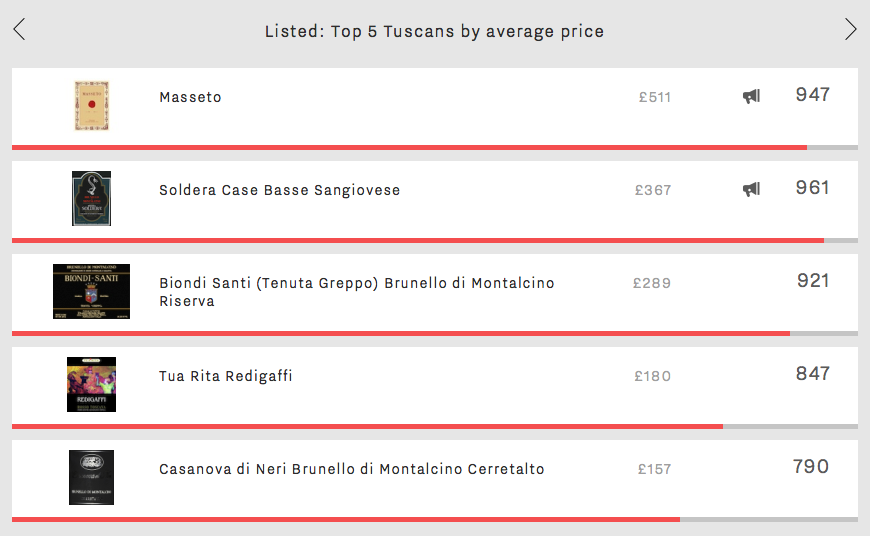
Two Brunellos feature amongst Tuscany’s most expensive wines: Biondi Santi’s Brunello Riserva (£289) and Casanova di Neri’s Brunello Cerretalto (£157). Whilst Biondi Santi Brunello Riserva’s appearance might be expected, considering its heritage, the fact that Casanova di Neri Cerretalto is amongst Tuscany’s most expensive wines might be more of a surprise, indicating that Riserva status alone does not currently guarantee higher prices than straight Brunellos.
Rounding out the five is Tuscany’s fourth-most expensive wine and the group’s second 100% merlot – Tua Rita’s Redigaffi. At an average price of £180 per bottle, it is over 2.5 times cheaper than its varietal companion in the group, Masseto.
While the jury is still out on pricing for Bordeaux 2017 (since the majority of key wines are yet to be released) Wine Lister can confirm, through scores from our partner critics, that the sweet whites from Sauternes and Barsac are some of the quality triumphs for 2017. The top five highest Quality scores for sweet whites all appear in the top 20 overall highest scores for Bordeaux 2017.
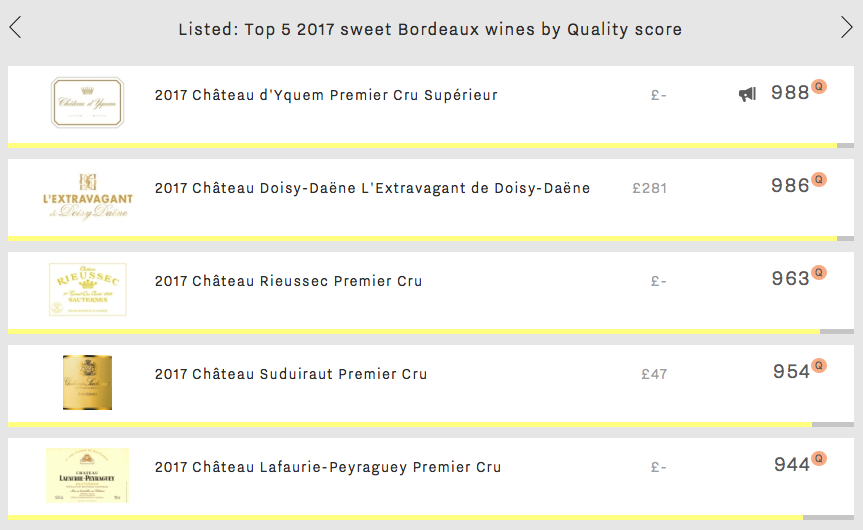
The highest Quality scorer not only for 2017 sweet whites, but for all 2017 Bordeaux is Château d’Yquem (988). Quality here is impressively consistent, with scores of 964-993 for the last 12 vintages (with the exception of 2012, when no wine was made for fear of compromising on quality following poor weather conditions throughout the growing season). Yquem is also a Brand tour de force, earning Wine Lister’s highest Brand score (matching Dom Pérignon Vintage Brut and three of the five red first growths, Lafite, Latour, and Mouton).
In second place, again not just for sweet white, but for Bordeaux 2017 in general, is L’Extravagant de Doisy Daëne. With a Quality score of 986, it is Wine Lister partner critic Antonio Galloni’s only potential 100-point scorer, earning 97-100 points and a laudatory tasting note; “…could very well turn out to be the wine of the vintage in Sauternes and Barsac…L’Extravagant is a total head-turner.” Doisy Daëne produced only 1000 37.5cl bottles of L’Extravagant this year (half their usual production level) – a fact that perhaps offers an explanation for the 2017 release price tag of c.£280 per 75cl, above current back vintages available on the market.
Suduiraut is Sauternes and Barsac’s third highest Quality scorer in 2017 (954). At wine level, Suduiraut performs better for Brand and Economics than L’Extravagant, and for a much lower price (£36 versus £256 on average per bottle). It benefits from presence in the world’s best restaurants and monthly online searches, both eight times those of L’Extravagant, no doubt due in part to production levels, which are 50 times higher.
Numbers four and five on this week’s top five list are Rieussec and Lafaurie-Peyraguey. Lafaurie-Peyraguey achieves its highest Quality score since 2007 (944). Rieussec’s Quality score of 963 places the 2017 vintage within reach of some of the greats for the domaine in recent years (namely 2015, 2009, and 2001). Its Quality strength is matched by a strong brand, benefitting from its place under the Domaines Barons de Rothschild umbrella.
However, like most Sauternes, its Economics score is weak. Rieussec does not have the best track record of price performance post-release (as seen on p.14 of our Bordeaux study), and this year released at €42 ex-négociant for the fourth consecutive year, above market prices for all recent vintages.
You can see more Bordeaux 2017 Quality scores on our en primeur page. Follow Wine Lister on Twitter for real time release updates throughout the Bordeaux en primeur campaign.
En primeur pricing is a crucial factor in the commercial success of top Bordeaux crus. With this in mind, Wine Lister has dedicated a section of this year’s Bordeaux study to the conundrum. We show historical pricing trends post release for a panel of 76 wines. The analysis indicates the effectiveness of release prices, based on the change between average ex-négociant release and current market prices (2009-2016 vintages):
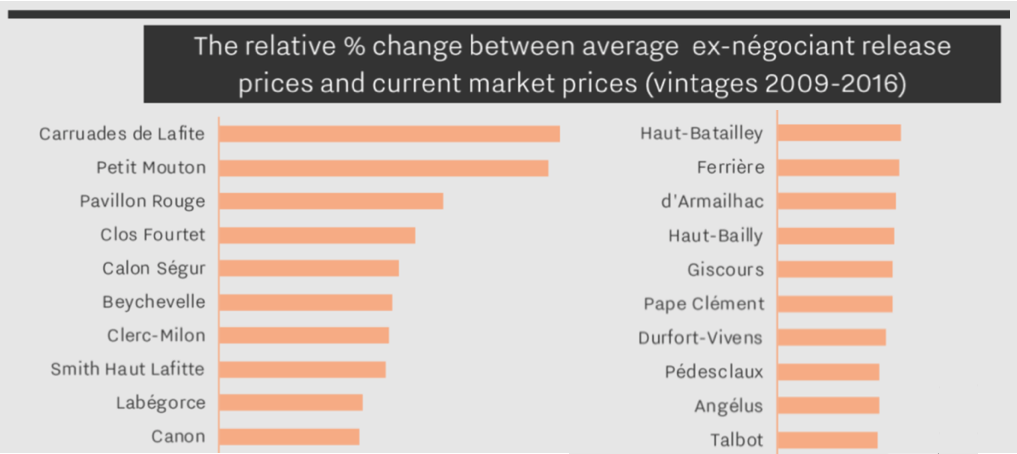
Above are the top 20 best-performing Bordeaux wines post en primeur release (to view the performance of all 76 wines, see page 14 of the Bordeaux study). The second wines of Lafite and Mouton have enjoyed the greatest gains in the marketplace, with Pavillon Rouge not far behind in third place.
Clos Fourtet is the best of the rest, followed by Calon Ségur, Beychevelle, Clerc-Milon and Smith Haut Lafitte. Lafite is the best-performing first growth, followed by Margaux and Mouton, with Haut-Brion making smaller gains.
This year’s en primeur campaign has not yet been met by the same enthusiasm as the 2016 or 2015 vintages. The average quality of 2017 is lower (by 10% if we take Wine Lister Quality scores for the same 76 wines) – a major factor in explaining price sensitivity, and why the average discount so far of 7% (9% excluding Haut-Batailley’s contrary price hike) is far from sufficient to oil the wheels of the campaign.
In our Bordeaux Market Study 2018, released just last week, we clarify an illustrative methodology for calculating release prices. Wine Lister looks at current market prices for similar recent vintages, and works backwards through three steps:
- Vintage comparison: As there is no obvious comparison for 2017, we apply the average quality to price ratio of the last nine vintages in order to arrive at a derived future market price, based on the average Wine Lister Quality score.
- Ex-château price: By removing the margins taken by the négociant and importer we reach the equivalent ex-château price.
- En primeur discount: Finally, we apply a discount of 10%-20% to incentivise buying en primeur, rather than waiting until the wine is physically available.
The chart below shows the theoretical application of this methodology to a basket of top wines. See page 13 of the Bordeaux study for a more detailed explanation.
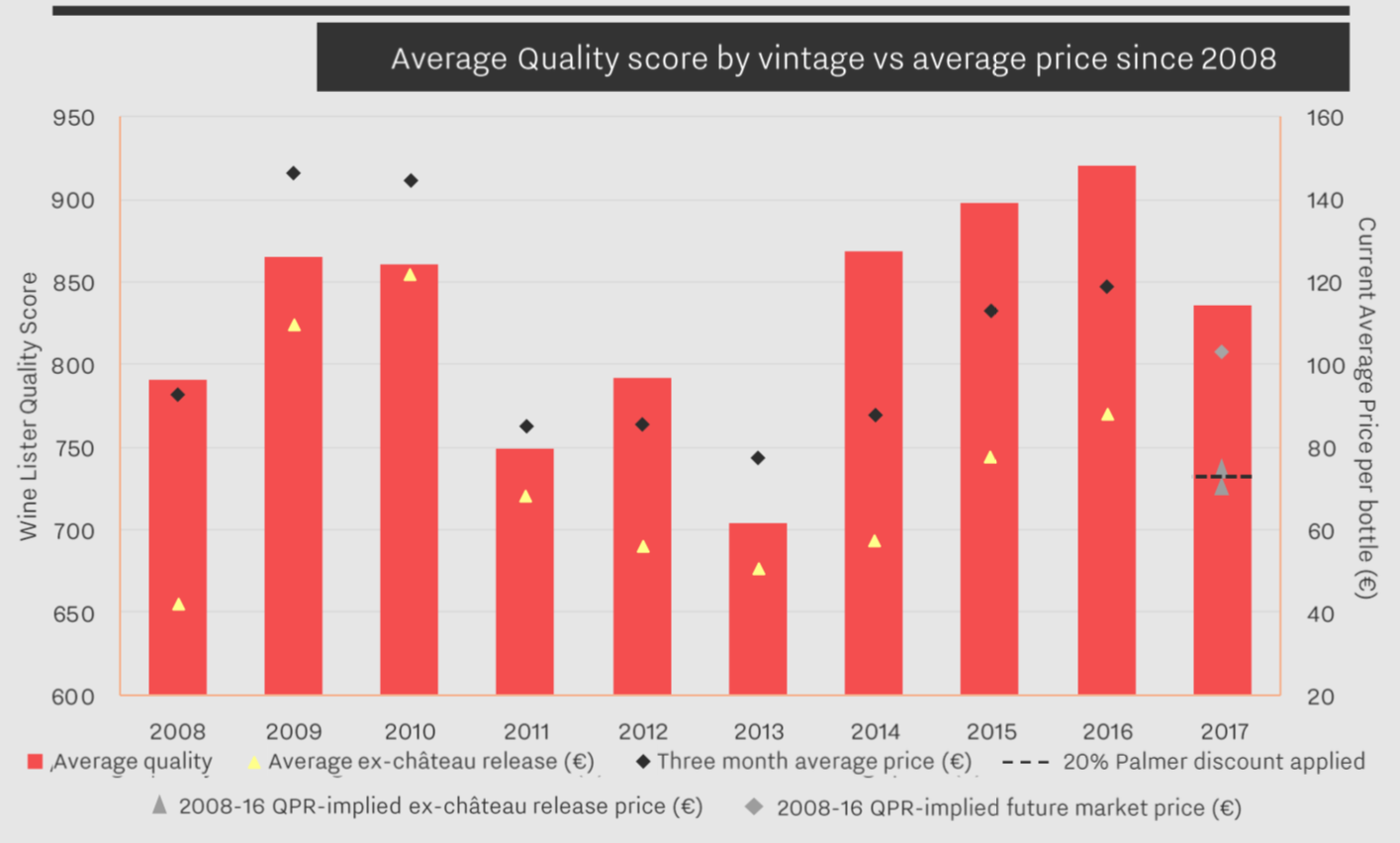
Prices released in the campaign thus far have varied from 20% discounts (Palmer, Domaine de Chevalier Rouge) to a 46% increase (Haut-Batailley) on last release prices.
Follow Wine Lister on Twitter for realtime en primeur release information, and use our dedicated en primeur page to compare 2017 release prices to last year.
Other wines featured in the top 20 best-performing Bordeaux post en primeur release are: Labégorce, Canon, Haut-Batailley, Ferrière, d’Armailhac, Haut-Bailly, Giscours, Pape Clément, Durfort-Vivens, Pedesclaux, Angélus, and Talbot.
Subscribers can download a copy of the full Bordeaux Study 2018 from the analysis page.
As we outlined in our introduction to the vintage, Bordeaux 2017 eludes generalisation. Striking arbitrarily, the late April frost resulted in a heterogenous Bordeaux vintage in terms of both volumes and quality.
Ahead of the official release of Wine Lister’s latest Bordeaux Market Study tomorrow (don’t forget to subscribe to secure full access, via the Analysis page)*, here we give you a preview of the top 20 Quality scores for Bordeaux 2017. Wine Lister’s Quality scores for Bordeaux 2017 are based on the recently-released scores for four of our five partner critics** – Jancis Robinson, Bettane+Desseauve, and Vinous’ Antonio Galloni and Neal Martin – as well as a small weighting for longevity:
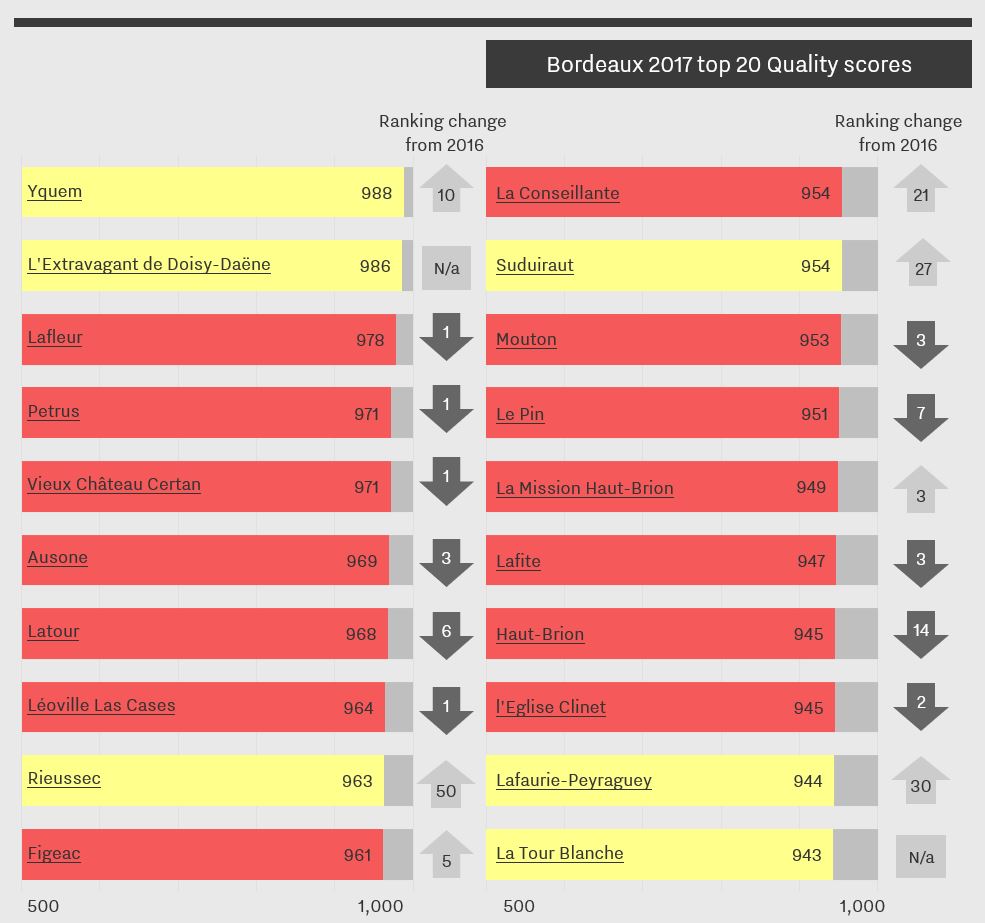
The frequent flashes of yellow in the chart above are testament to the kindness of the 2017 vintage to Bordeaux’s sweet whites, with Yquem and L’Extravagant de Doisy-Daëne achieving first and second places (scoring 988 and 986 respectively). Other sweet wines, Rieussec, Suduiraut, and Lafaurie-Peyraguey make some of the largest gains on their 2016 positions. Sauternes & Barsac stand out as the only appellations whose combined 2017 Quality score is above that of the 2016 (up 21 points).
When it comes to reds, the right bank fares best, and is home to seven of the vintage’s top 10 wines, five of them from Pomerol. Lafleur is the top-scoring red (in third place overall) with a Quality score of 978, followed by Petrus and Vieux Château Certan on 971 apiece. Pomerol’s La Conseillante makes the largest strides of any red wine in the top 20, up 21 places since 2016.
Overall, Pomerol is the highest-scoring appellation of the vintage, with an average Quality score of 959 (nonetheless down 25 points from 2016).
The left bank has fared less well with two of the five left bank appellations seeing score decreases of c.10% (Margaux and Saint-Estèphe, achieving 850 and 829 respectively). Despite dropping six places – from the top spot last year – Latour wins the left bank crown, followed by consistent overperformer Léoville Las Cases.
Other wines featuring in the top 20 Bordeaux 2017 Quality scores are: Ausone, Figeac, Mouton, Le Pin, La Mission Haut-Brion, Lafite, Haut-Brion, l’Eglise Clinet, and La Tour Blanche. You can view Quality scores for wines outside the top 20 here.
*Now published: for more analysis of the 2017 vintage, subscribe to read our Bordeaux Study.
**Jeannie Cho Lee was unfortunately unable to travel to Bordeaux to taste this year.
The majority of Antonio Galloni’s Bordeaux 2017 scores have been added to Wine Lister. The release of his Saint-Emilion satellites will complete Vinous’ coverage of Bordeaux en primeur 2017. Below is an overview of his top-scoring wines so far for this vintage:
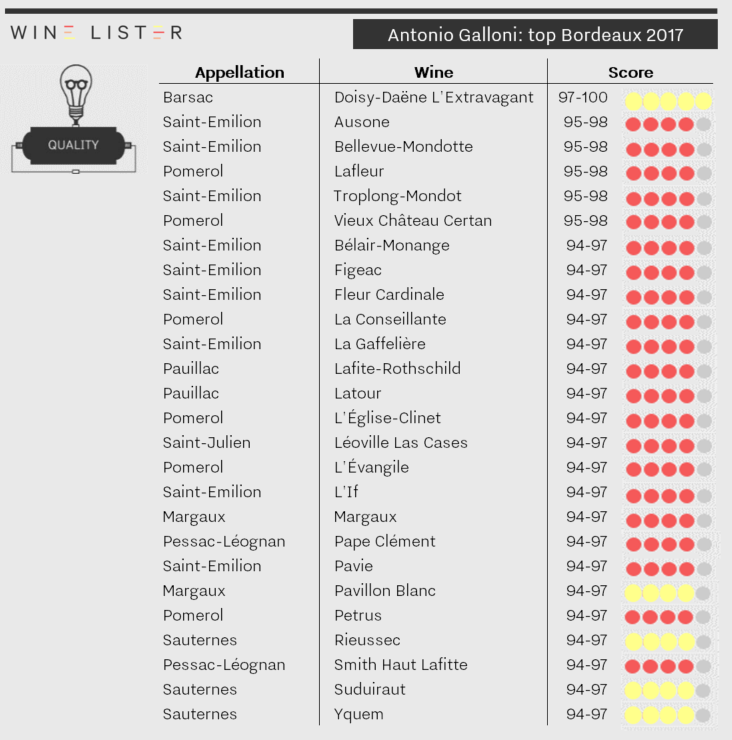
The only potential perfect scorer is Doisy-Daëne L’Extravagant (97-100). This strengthens the case for the Sauternes & Barsac appellations as the biggest successes of the 2017 vintage (see top scores from Bettane+Desseauve, Jancis Robinson and Neal Martin for comparison).
Five wines scored 95-98 points, and they are all from the right bank, which Galloni explicitly declares to be superior to the left bank in 2017. Lafleur, released today exclusively by Justerini & Brooks, achieves the top score bracket for a red wine from all four of Wine Lister’s partner critics, making it the red wine of the vintage.
It is joined at the top of Galloni’s picks by Ausone, Bellevue-Mondotte, Troplong-Mondot, and Vieux Château Certan.
The next score category, 94-97, is also dominated by the right bank, featuring 10 wines from Saint-Emilion or Pomerol and just six red wines from across the whole of the Médoc and Graves. The surprise entry is L’If, from the Thienpont family, which outscores its venerable older sibling, Le Pin (93-96).
Three left bank first growths make the cut: Lafite, Latour, and Margaux. Alongside its big brother, Pavillon Blanc is Galloni’s top scoring dry white 2017, also achieving 94-97 points.
Other wines scoring 94-97 from Antonio Galloni include: Bélair-Monange, Figeac, Fleur Cardinale, La Conseillante, La Gaffelière, L’Église-Clinet, Léoville Las Cases, L’Évangile, Pape Clément, Pavie, Petrus, Rieussec, Smith Haut Lafitte, Suduiraut, and Yquem.
All these scores are now live on the wine pages of our website for subscribers to view (alongside those of Bettane+Desseauve, Julia Harding MW and Neal Martin), with links through to Antonio Galloni’s tasting notes on Vinous.com. Have a look at Antonio Galloni’s coverage of Bordeaux 2017 here. NB. As Jeannie Cho-Lee did not taste the 2017 Bordeaux, Antonio Galloni’s scores complete Wine Lister’s Quality scores for the vintage.
While the wine world lives and breathes Bordeaux during this year’s en primeur season, Wine Lister looks at some high-scoring Bordeaux reds that could easily be overlooked amidst the sea of releases to choose from across Médoc classified growths and beyond. Below we examine the top five fourth growths by overall Wine Lister score.
The highest-scoring Bordeaux fourth growth on Wine Lister is Château Beychevelle, with a score of 879. Its trailing Quality score of 790 is boosted by Brand and Economics scores of 980 and 904 respectively. Meanwhile, Beychevelle’s 2016 and 2015 vintages achieve Quality scores more than 15% higher than its wine-level average. It will be interesting to see how the 2017 vintage (with a Quality score of 805 thus far, based on partner critics Bettane+Desseauve, Neal Martin and Julia Harding MW for Jancis Robinson) is priced during this year’s en primeur campaign in the coming weeks.

In second and third place are Château Talbot and Château Branaire-Ducru, achieving Wine Lister scores of 859 and 842 respectively. Talbot is the most popular of the five, receiving 14,602 searches each month on Wine-Searcher, resulting in the group’s best Brand score (983). Talbot’s position as a ubiquitous Bordeaux brand is no doubt helped by a production level of c.400,000 bottles per annum – over twice as many as Branaire-Ducru.
The fourth entry and only Pauillac to feature, Duhart-Milon, has the lowest Quality score of the five (752), but carries a Brand score of 916 points. It is no surprise that, as part of the Lafite group, it is the most-traded Bordeaux fourth growth at auction, its top five vintages having traded 1,186 bottles over the past four quarters.
Finally, Lafon-Rochet appears in the Listed blog for the second week in a row (previously featuring in the top five Saint-Estèphes by Economics score). At 800 exactly, Lafon-Rochet’s Wine Lister score is safely in the “very strong” category on the 1,000-point scale. In the context of this week’s top five it has the third-highest Quality score (770), but its price per bottle is 41% below the rest – a savvy buy!
Bordeaux 2017 en primeur scores are now out from Neal Martin for Vinous.com – our US partner critic, and one of the most prominent voices of international wine criticism today. (Antonio Galloni’s scores are due out this Thursday, 3rd May). This is the first time Wine Lister has featured Neal Martin’s scores after he joined Vinous in February this year. Below are his scores equal to or above 94-96:
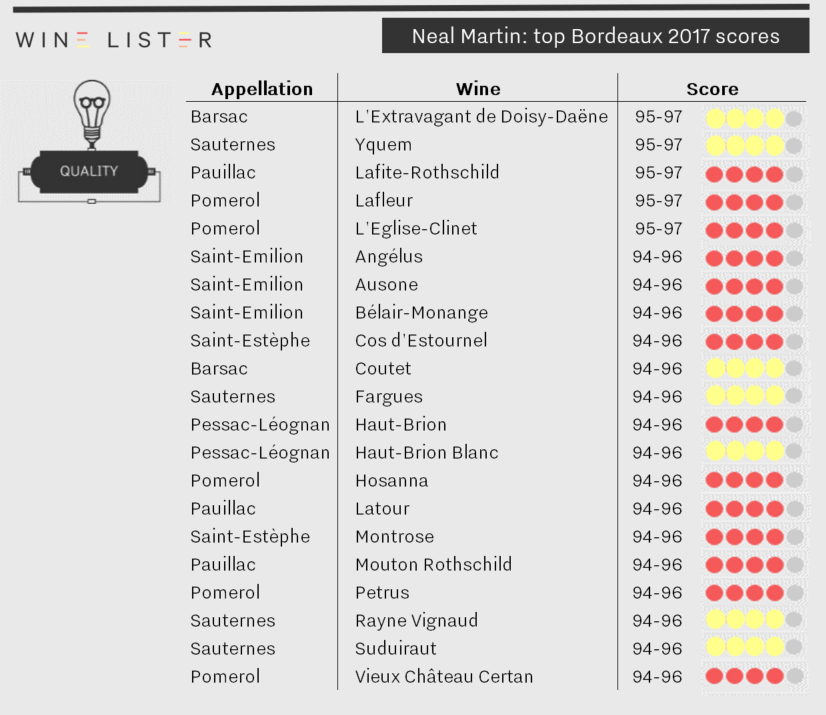
No wines earned perfect scores this year (in contrast with 2016, where Martin awarded a potential 100 points to eight wines), with five wines achieving Martin’s highest potential score of 97.
With a score of 95-97, Yquem sits in the top score bracket for the third time, already awarded 18.5 and 19.5-20 by Julia Harding MW (on behalf of Jancis Robinson) and Bettane+Desseauve respectively.
Similarly to Bettane+Desseauve, Martin’s appreciation for the quality of Sauternes and Barsac in 2017 is clear, with five other sweet whites making his top 21 (L’Extravagant de Doisy-Daëne, Coutet, de Fargues, Rayne Vignaud, and Suduiraut).
Lafite is Martin’s highest scoring Médoc first growth, which he describes as “classic from start to finish”. Joining the high rankings are first growths Haut-Brion (and its white), Latour, and Mouton, all earning 94-96 points.
The right bank figures strongly too. Two Pomerols (Lafleur and L’Eglise-Clinet) equal Lafite’s score, with three more earning 94-96, alongside three wines from Saint-Emilion. Ausone, like Yquem, makes its third appearance in top scores for Bordeaux 2017 from Wine Lister partner critics. “What a great Ausone this is destined to be,” comments Martin.
Bélair-Monange is perhaps the stand-out entry, described by Martin as, “the jewel in the crown of J-P Moueix… an assured, and bewitching Saint-Emilion”.
Other wines scoring 94-96 from Neal Martin include: Angélus, Cos d’Estournel, Hosanna, Montrose, Petrus, and Vieux Château Certan.
All these scores are now live on the wine pages of our website for subscribers to view (alongside those of Bettane+Desseauve and Julia Harding), with links through to Neal Martin’s tasting notes on Vinous.com. Read Neal Martin’s coverage of Bordeaux 2017 here.
Vinous coverage will be completed by Antonio Galloni’s scores, due for release on Thursday 3rd May.
2015 was a phenomenal vintage for reds in Burgundy. However, parts of the Côte de Beaune were affected by frost, and the quality of 2015 whites is therefore less consistent. Below we examine the top five white Burgundy 2015s by overall Wine Lister score.
Domaine Leflaive takes two of the five top spots. Its Chevalier-Montrachet has the highest overall Wine Lister score of all white Burgundies in 2015 (963). This is thanks to a Quality score of 962 (four points higher than the wine’s average across the last fifteen vintages) and an impressive Economics score of 991.
Domaine Leflaive’s Bâtard-Montrachet comes in third place. Both wines benefit from Domaine Leflaive’s position as a superstar white Burgundy brand. Indeed, five of the 10 highest white Burgundy Brand scores are held by wines from Domaine Leflaive.
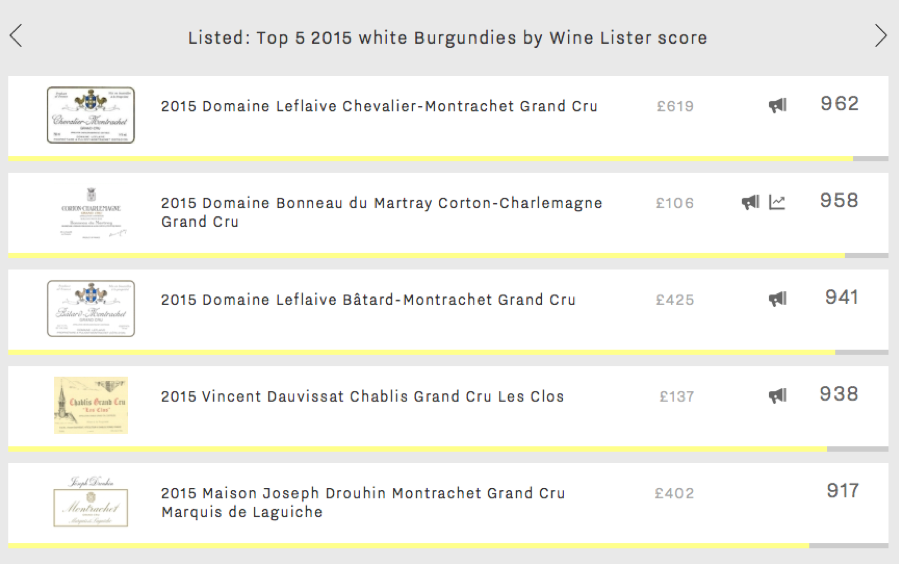
The second highest overall scorer of white Burgundy 2015 is Domaine Bonneau du Martray’s Corton-Charlemagne (958). It is both the highest Quality scorer (977, 10% above its average) and the lowest priced (£106 per bottle) of the five, presenting an interesting value opportunity. It is also to be found in 36% of the world’s top restaurants, the most prestigious count of this week’s top five.
Chablis is represented by Vincent Dauvissat’s Grand Cru Les Clos. Identified as one of only three Chablis Buzz Brands on Wine Lister, Dauvissat’s Cru Les Clos is present in 23% of the world’s top restaurants, helping it to a Brand score of 907. Its overall Wine Lister score of 938 for the 2015 vintage is completed by a Quality score of 947 and its second strongest ever Economics score of 969.
Finally, Maison Joseph Drouhin’s Montrachet Grand Cru Marquis de Laguiche has the fifth highest Wine Lister score for white Burgundy 2015s (917). Though it has the lowest global restaurant presence, it is more present than the other four wines in top restaurants in Asia.
This week, Wine Lister determinedly battles through the cold to bring on spring with the vinous ray of sunshine that is Sauvignon Blanc. The Loire valley is, for many, the holy grail of Sauvignon Blanc production, creating pure, age-worthy examples of the grape. Interestingly, Wine Lister’s top five Loire Valley dry whites for Quality all hail from the Easternmost tip of the Valley – Pouilly-Fumé and Sancerre – thus edging out stiff competition from the more Westerly Chenin Blancs.
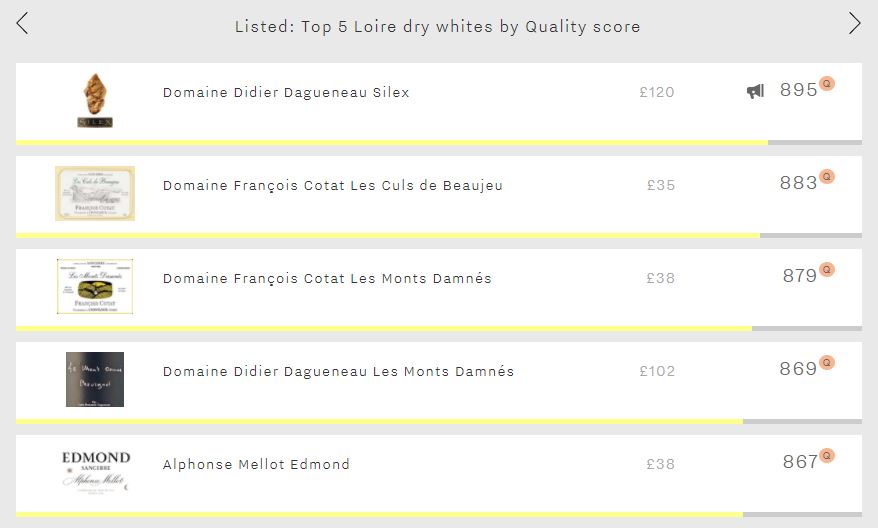
Whilst none of the top five breach the 900-point mark – thus not quite making it into the most elite band of Wine Lister’s 1,000-point scale – they don’t miss out by far, and are separated by just 28 points. Notably, two producers dominate – Dagueneau and François Cotat – filling four spots, with Alphonse Mellot’s Edmond taking the remaining place.
In top spot is Dagueneau’s Silex with a score of 895. This iconic Pouilly-Fumé – or Blanc Fumé de Pouilly as the domaine refers to it – might not be the Loire’s longest-lived dry white, but leads thanks to excellent critics’ ratings, with French duo Bettane+Desseauve awarding it 18.5/20 on average. Not only is it the Loire’s top dry white for quality, it also achieves the best Brand score of any Loire Valley wine – it is 68% more popular than any other wine from the region and its famous flint-emblazoned bottle is visible in 39% of the world’s top restaurants.
Second and third spots are taken by two Sancerres from François Cotat – Les Culs de Beaujeu (883) and Les Monts Damnés (879). François Cotat, along with his cousin Pascal inherited their respective domaines when their fathers – Paul and Francis – retired in the early 90s. The cousins decided to split production, with François continuing to make his wines in Chavignol, whilst Pascal built a new winery in Sancerre. François’ Les Culs de Beaujeu and Les Monts Damnés comfortably achieve the longest drinking windows of this week’s top five – 12 and 13 years respectively – at least three years longer than the remainder of the group.
Fourth and fifth spots are filled by Dagueneau’s Les Monts Damnés (869) and Alphonse Mellot’s Edmond (867). Whilst they are separated by just two points in terms of Quality, the former is over 2.5 times more expensive, perhaps thanks to Domaine Dagueneau’s cult status.
For wine lovers the world over, Burgundy is a region to be celebrated all year round. That being said, the modern interpretation of the traditional, post-harvest festival, La Paulée de New York, holds its West Coast counterpart this week, celebrating some of Burgundy’s finest producers in San Francisco’s best restaurants.
With Burgundy on the brain, we look back at our recent Burgundy study and the results of our Founding Members’ survey. Wine Lister asked 52 key members of the global wine trade across importers, merchants, and auction houses to rate their confidence in certain domaines from 0 to 10.
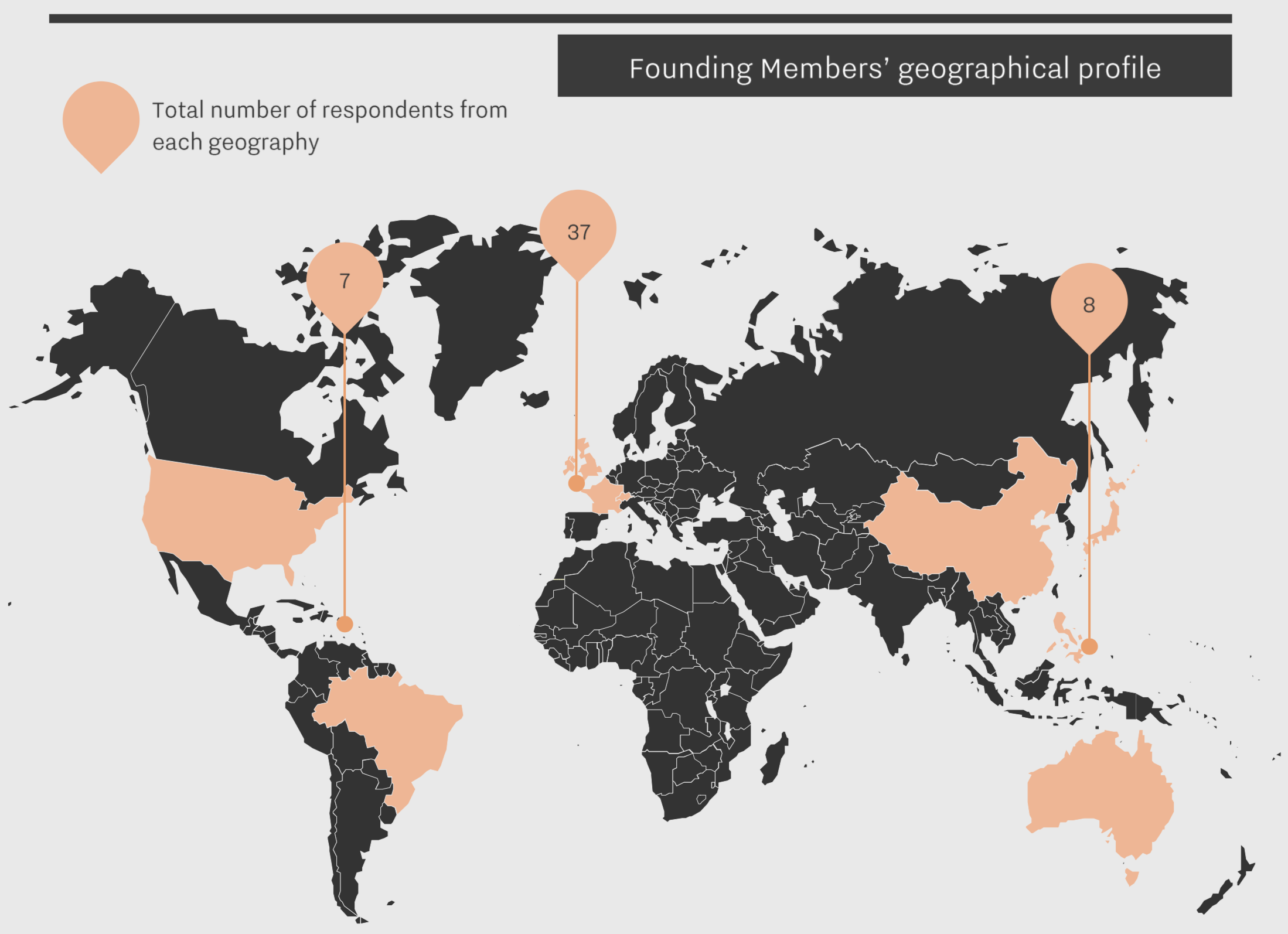
Our Burgundy study is the first to feature producers with a perfect confidence score. In Burgundy, two producers received a rating of 10/10. It perhaps comes as no surprise that Domaine de la Romanée-Conti (DRC) should be one of them. The other, Domaine Rousseau, is likely to have the strong performance of its Chambertin to thank for its perfect confidence score (Rousseau’s Chambertin holds the fifth best overall Wine Lister score in Burgundy, after four DRC wines).
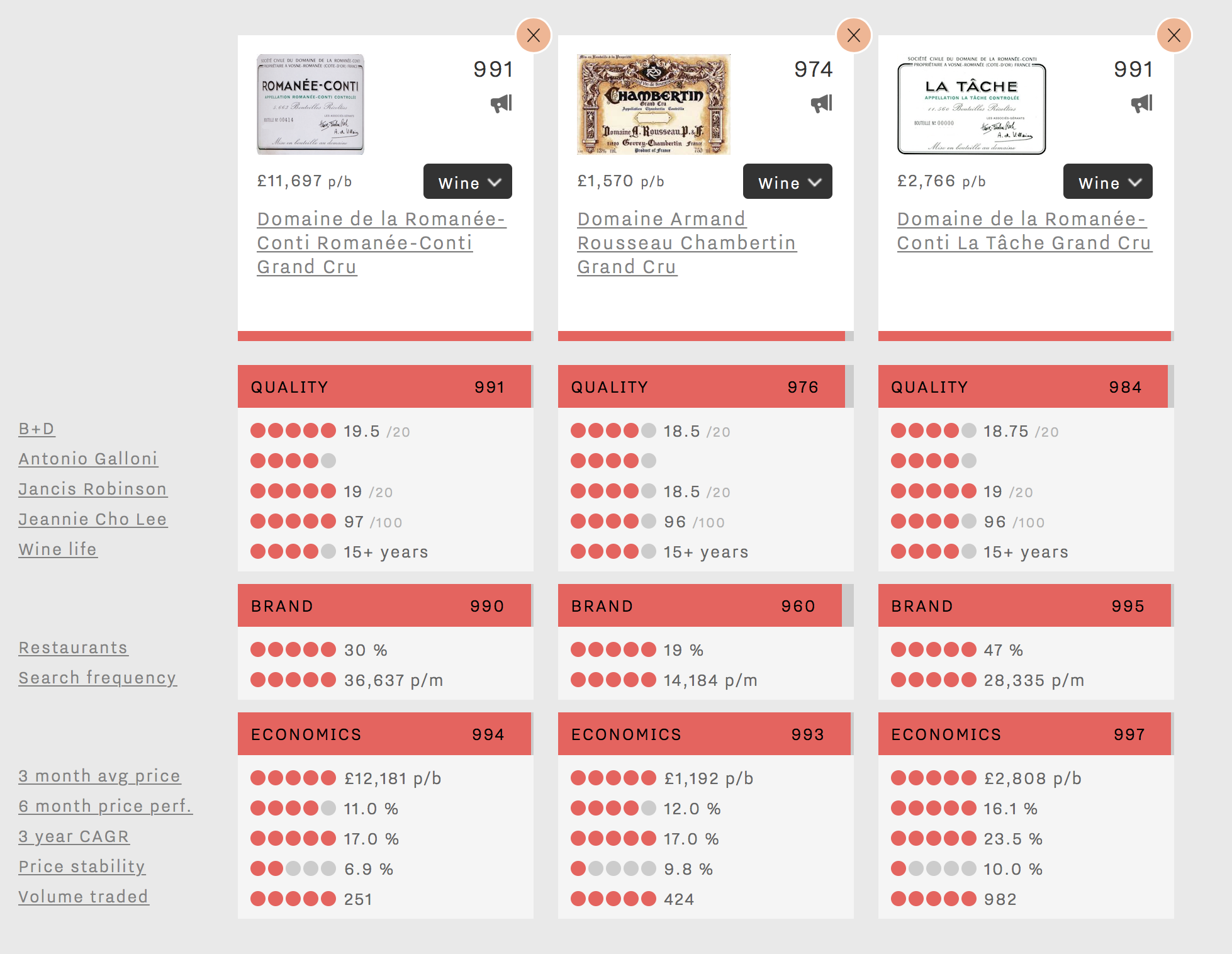
Six producers achieved a confidence rating of 9/10. D’Auvenay and Domaine Leroy’s marks confirm the trade’s outstanding level of confidence in Lalou Bize-Leroy. Whilst Mugnier and Roumier fly the flag for Burgundy’s top red producers, Coche-Dury and Raveneau show that the trade is sure about the prospects of the region’s most prestigious white wine producers.
26% of producers included in the survey gained a confidence rating of 8/10. Among them, Comtes Lafon, Ente, and Roulot confirm the prospects of Meursault and its top producers.
36% of producers received a score of 7/10 – still a strong result and underlining the trade’s high level of confidence in Burgundy. This confidence seems linked to the region’s consistent price performance, as one US fine wine auction house notes: “The single most interesting trend is pricing. Demand on the primary and secondary market is high, and it’s amazing to see that prices have not gone down at all…in years.”
For context, no Burgundy producer scored below 5/10, compared to 5% of Bordeaux wines in Wine Lister’s Bordeaux study last year.
For more detail on which Burgundy producers achieve top confidence ratings, see our full Burgundy study here, or subscribe to gain access.
For those joining the La Paulée festivities, we wish you a very happy Burgundy week!












